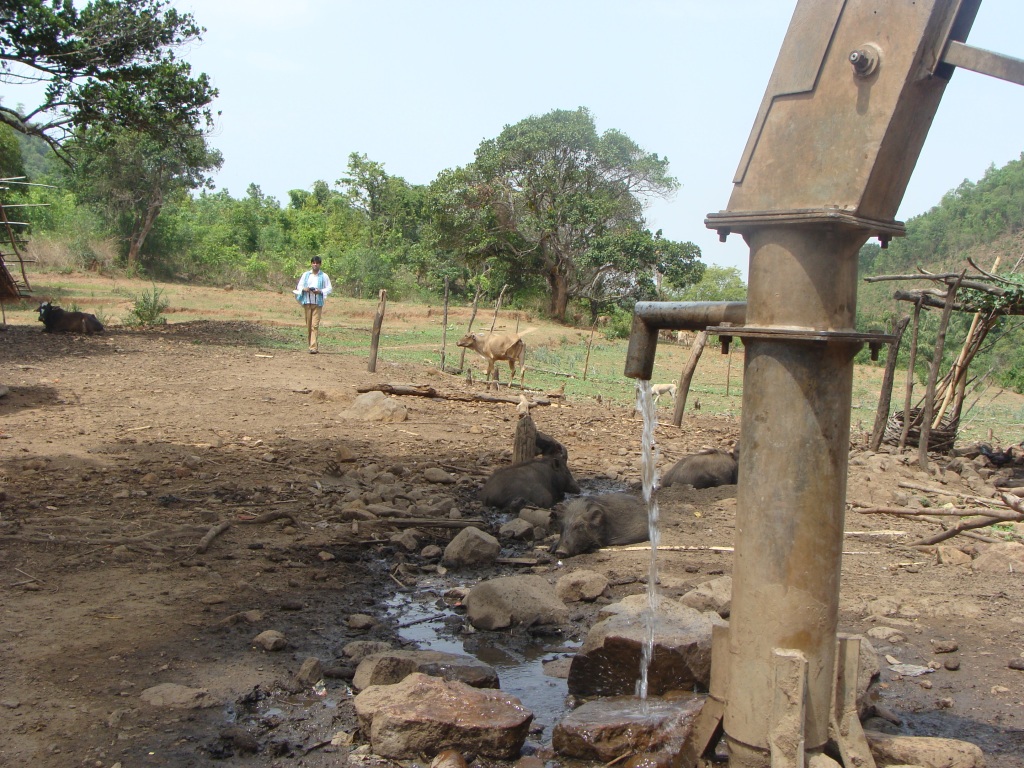“We had 200 vacancies, but we could not even fill even 50% of the posts,” said Group Captain T K Singha, Chief Public Relations Officer, Ministry Of Defense. “Most of the students failed the basic medical test because of defects in bone structure,” said an officer. “This was not visible by the naked eye, nor did it affect normal life.” “We found out most of the candidates came from arsenic affected regions of Bengal, and drink water from Hand Pumps”. It further says that the Arsenic contamination of groundwater in West Bengal was detected more than 30 years ago, according Sudarshan Niyogi, Professor of Chemical Engineering at IIT-Kharagpur. “Arsenic can affect any organ, including bones, causing deformity, brittleness and degeneration”. Weblink- http://bit.ly/IPuTP6
A field based story I wrote in 2005 for IRC ‘The Mystery of the Indian Village Water’ which is also available at http://www.source.irc.nl/page/26898: “..We met a 13-year-old girl Janglee and a boy, 7-year-old Kamal. Both are physically and mentally disabled, and could not even stand on their own for long. Janglee and Kamal cannot play with friends and they move around in acute pain in the limited world of their small hut. Kamal’s father works hard for US $1 a day and has spent US $200 (EUR166) for treatment in last few years with no improvement.
“..The only alternate is to drink water from the hand pump…water authorities have already met their water supply targets. They need more funds to manage the severity of the spreading fluoride problem…as their current priority is ‘improved sanitation’ to each household in Padharapura and nearby villages.”
“Health Authorities are not aware of the severity this endemic fluoride problem. In Dhar district of Madhya Pradesh, 324 villages with 980 water sources are affected with similar problem. Mitigation measures and institutional coordination at every level are shockingly negligible.”
There is another article that talks about the situation in urban slums/un-organized coloinies “The public services fall short, largely because, they have little or no accountability to the ultimate client, and outdated management systems are unable to provide the information needed for decision-making…These colonies are extremely unhygienic, filth ridden and are ones nightmare to live. There, you will not find basic services and civic amenities, and in case someone gets that, is a different story altogether.” Weblink http://water.thinkaboutit.eu/think5/post/urban_water_and_sanitation_who_cares_about_poor
My experience says that we need to establish a robust and functional water quality monitoring system on an urgent basis as there are hardly any evidences on sustaining water quality monitoring systems in the majority of Indian states.
I have come across laboratories that are sometimes fairly equipped with water quality testing instruments, but there are two major issues we face which are related to getting timely and regular samples and the need felt by our functionaries on this front, except in extreme cases when they by-chance find severe problems of biological or chemical contamination.
Therefore, laboratories equipped with high-end equipment’s will do less in such scenarios. As it has been seen the majority of the agencies focus on just providing equipment’s to the government laboratories, rather than focusing on capacity building and establishing monitoring networks. In states with district based laboratories, the laboratory technicians and assistants usually complain that they are not supposed to collect samples, but, are dependent on the respective Junior Engineers or villagers to get them and this is not a regular process of sampling.
Given that the Government of India had focused on this issue during the last five years we still don’t have field based results in this regard. In my opinion the following are the ways forward:
- Given the importance of safe water and its effects on health and the overall socio-economic well-being, there should be mandatory provisions towards water quality monitoring in each water supply scheme or system. It may cost but, given the importance we should have water quality monitoring of each source on a quarterly basis.
- The institutional framework for the above should be framed accordingly and similarly the kind the laboratory and equipments should be based on the need of the area (e.g. affected with fluoride, arsenic, nitrate, etc.).
- Initially adequate financial support for such a programme should be given by the government and later with regular facilitation and technical support the communities could take the ownership.
- The responsibility of water quality sampling and monitoring should be given to the laboratory technicians/assistants and their performance should be evaluated based on the kind of work completed by them and also the head of the department (e.g. Executive engineer of PHED) should be made responsible for any discrepancy or poor performance at their end.
- Though we have an online water quality status portal developed by the Government of India, this needs further coordination, compliances and follow-up with state level offices.
- Each state should also have a separate water quality monitoring and surveillance system that is linked to national level data base and should be such that it can be accessed quickly by anyone for planning purposes.
- In water quality monitoring and surveillance programme, the MDWS needs to coordinate with the Ministry of Health and Family Welfare and the state level health agencies to help the affected communities. All doctors and their team members should be given adequate trainings on all water quality related issues and impacts.
- There should be a single, robust water quality monitoring system, and precaution should be taken that there should not be duplication of efforts in this direction. Towards this, agencies could also be assigned the responsibility of specific districts or states.
- The state and Government of India’s web portal should have all information related to different kinds of water quality issues, precautions, surveillance measures, mitigation measure, etc. This should also be available in local languages and based on the local problems in each state.
News bytes on water quality related issues could be circulated in local and national channels, so that people understand and take health and water quality linkages seriously

Leave a comment